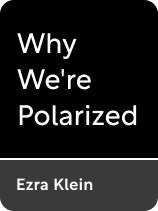

This article is an excerpt from the Shortform book guide to "Why We're Polarized" by Ezra Klein. Shortform has the world's best summaries and analyses of books you should be reading.
Like this article? Sign up for a free trial here.
Why are Americans so politically divided? Can anything be done about it?
Why We’re Polarized by Ezra Klein argues that Americans are split into two sharply contrasting groups rooted in partisan identities. He believes this is a departure from previous eras when political divides were more about issues than identities.
Continue reading for an overview of this book that provides insight into what’s going on in America today.
Overview of Why We’re Polarized by Ezra Klein
Why We’re Polarized by Ezra Klein (American progressive journalist, political commentator, and podcaster) contends that the clustering of nearly the entire electorate into the Democratic and Republican camps is not a story about routine political disagreements—like how high the top marginal income tax rate should be or what percentage of GDP the federal budget should be. Instead, it’s a story about identity. Specifically, writes Klein, our partisan political identities have become overarching super-identities that encompass and activate our most deeply felt personal, religious, linguistic, socioeconomic, and ethnic/racial identities.
In America, observes Klein, these underlying lines of division all come together in one main division—between Democrats and Republicans—that makes bipartisan cooperation increasingly difficult.
We’ll explore Klein’s central argument by examining:
- The origins of modern political polarization in the politics of the mid-20th century
- How polarization has made American politics a winner-take-all struggle that leaves little room for compromise
- How polarization has differently affected the two major political parties
- Potential solutions to the crisis of polarization
| Critical Reaction to Why We’re Polarized When Why We’re Polarized was published in 2020, it was largely seen by critics and the general public as a worthwhile and meaningful contribution to the American political science canon, offering insightful analysis into the origins and impacts of America’s polarized politics. The New York Times praised the book for its success in translating decades’ worth of political science studies, peer-reviewed behavioral psychology papers, electoral data, and political history to put the phenomenon of partisan polarization into a coherent analytical framework. On the other hand, The New Yorker criticized Klein for attributing the rise of polarization to broader social, cultural, and economic changes in the nation. Instead, argues The New Yorker, Republican political operatives deliberately engineered the country’s partisan fracturing for their party’s electoral benefit. Some reviewers, meanwhile, wrote that Klein’s own progressive politics compromised the book’s arguments. The Wall Street Journal said he reductively framed the American electorate as divided between racists and nonracists—and that he placed his conservative opponents indisputably on the “racist” side of this divide. |
Part 1: The Roots of Modern Polarization
To understand the polarized political landscape we inhabit today, it’s important to understand how we got here. Was American politics always like this? Did politicians always seek to stir up partisan fervor among their supporters by antagonizing the other side? According to Klein, the answer is “no.” He writes that the story of modern polarization is rooted in cleavages in the political system that began in the 1950s and 1960s, during the civil rights era.
Mid-20th Century Politics: Light on Partisanship
Klein writes that in the mid-20th century, the two major parties were less polarized because their underlying coalitions were far more heterogeneous than they are today. For example, there were lots of liberal Republicans in New England, while conservative white Southerners (“Dixiecrats”) were the backbone of the Democratic Party. The two parties were loose coalitions. This stands in stark contrast to the parties of today, both of which are tightly ideologically disciplined, with little ideological crossover between them.
Because of the less cohesive nature of the two parties, there was lots of cross-partisan political behavior: Major pieces of legislation passed with bipartisan majorities, there were lots of swing voters, and many states frequently shifted back and forth between the parties from election to election.
The Dominance of the Dixiecrats
Klein writes that to understand this mid-20th century era of bipartisan comity—and how it ended—we need to understand the Dixiecrats. The Dixiecrats—conservative, white, segregationist Southern Democrats—were the backbone of the Democratic Party from the 19th through the mid-20th century. Through their domination of Southern politics, they established a system of authoritarian, one-party rule in the South. Supporting this system was a range of suppressive tactics, ranging from legal disenfranchisement to intimidation, segregation, and violence against African Americans. Klein argues that maintaining this system of racial hierarchy was the chief political goal of the Dixiecrats.
Because they were critical to giving the overall majority to the Democratic Party in Congress, Dixiecrats had great influence in Democratic politics at the national level. And the national Democratic Party—which generally became more progressive and egalitarian in the 20th century—had little choice but to placate its Dixiecrat partners by turning a blind eye to the system of racial apartheid in the South. In practice, Klein writes, this meant that liberal Democrats who wanted to get anything done at the national level—from establishing Social Security and Medicare to passing pro-union legislation—had to accommodate the Dixiecrats.
The Dixiecrats Exit the Democratic Party
Klein writes that the partnership between the Dixiecrats and the rest of the Democratic Party began to change in the mid-20th century as the liberal wing of the Democratic Party began to more aggressively and boldly support civil rights legislation.
The enactment of the 1964 Civil Rights Act and the 1965 Voting Rights Acts (passed by a Democratic Congress and signed by Democratic President Lyndon Johnson) were watershed moments in American political history. The Democrats were now the national party of civil rights, which deeply alienated the Dixiecrat wing of the party.
This, observes Klein, was the beginning of the great ideological reshuffling of the two parties, as conservative white Southerners started their long exodus from the Democratic Party into the Republican Party. The GOP proved a welcome home for them, as the former Dixiecrats—alarmed by the threat of federal desegregation efforts—suddenly found the anti-government ideology of conservative Republicans highly appealing.
Our Hyper-Polarized Present
In the 2020s, writes Klein, we’re experiencing the culmination of this process. Over the decades, politics became sorted along ideological and racial lines: Conservative white Christians migrated to the Republican Party, while liberal, multiethnic, secular voters increasingly found their political home in the Democratic Party. The result is a political landscape in which nearly all voters are neatly ideologically sorted into one political party or the other.
Part 2: The Dynamics of Polarization
Having traced the origins of American political polarization, we can explore how it functions in contemporary politics. According to Klein, polarization creates a set of dynamics in American politics that make it a winner-take-all contest between the two parties. The dynamics of polarization, he writes, create a positive feedback loop: Partisan voters feel increasingly hostile toward one another and reward politicians who deliberately antagonize the other side, driving further rounds of polarization.
In this section, we’ll explore the underlying mechanics of this dynamic, looking at how identities trump issues in American politics, why our partisanship is driven primarily by negativity, and how these factors give politicians an incentive to stoke further division.
Identities Over Issues
Klein observes that our partisan differences stem less from disagreements about what we believe than about who we are and who we believe our opponents to be. In other words, identities, not issues, are what drive our political behavior.
He writes that our disagreements run far deeper than straightforward economic questions like, “Will this bill help improve the roads in my town?” or, “Which candidate or party will help lower the cost of prescription drugs?” Instead, partisanship operates at a more fundamental, tribal level: We support the party that we believe represents people like “us” and that will help us defeat and punish the hated “others.”
The Pull of Negative Polarization
In Klein’s analysis, these identity-based politics transform political competition into an all-or-nothing, us vs. them struggle marked by a phenomenon political scientists call “negative polarization”—we hate and fear the other political coalition more than we love and admire our own. In other words, loyal Democratic Party voters aren’t Democrats because they have deep love and admiration for the Democratic Party and all it stands for. Instead, they have an abiding fear of and hatred toward the Republican Party, and they view the Democrats as their only bulwark against them.
The Impossibility of Compromise
Klein writes that this level of extreme partisanship makes democratic governance all but impossible. After all, you can’t compromise or accept the normal give-and-take of democratic governance (like losing elections), because to do so would risk letting the hated other side “win.” And when your partisan rivals are feared and despised rivals who you believe want to destroy everything you cherish (instead of merely being a group that you disagree with on routine political matters), you’ll inevitably come to see every election as an ultra-high-stakes contest. Ultimately, writes Klein, both sides develop a mentality of winning at all costs—because the other side is simply too radical, dangerous, and different to be trusted with power.
Polarization Leads to More Polarization
Klein points out that the US political system operates according to the logic and incentives that our polarized society imposes upon it. He writes that divisive and fear-mongering politicians aren’t necessarily evil or malicious people. Instead, they’re responding rationally to their political incentives—and those incentives are to demonize and antagonize the other party. In other words, it’s politically advantageous for politicians to refuse to compromise and to stir up the most partisan reactions among their supporters. Electorally speaking, it pays to be a divider.
Part 3: Polarization Has Affected the Two Major Parties Differently
Klein writes that while polarization has affected the composition and electoral strategies of both major parties, its effects have not been equal—instead, he observes, the Republican Party has been far more deeply distorted by polarization than the Democratic Party.
The Diversity of the Democratic Party
Klein argues that the Democratic Party has been less vulnerable to polarization because of its diverse makeup. Democrats, he writes, are a broad coalition of different racial, religious, and other demographic groups. Within those demographic groups, there’s also lots of ideological diversity. For example, although they remain staunchly Democratic, lots of Black and Latino voters have socially conservative views, particularly on issues related to gender and sexual orientation.
The diverse composition of the party’s base acts as a moderating influence and a check on polarization: Candidates need to win over a broad demographic and ideological coalition to be nominated, and they need to compromise once they’re in office. Left-wing activists, argues Klein, do not control the Democratic Party or set its agenda—rather, they are one constituency among many that Democratic politicians need to cater to. Thus, Democrats can’t be pulled too far left, because if they did, they wouldn’t be able to hold their coalition together.
The Uniformity of the GOP
According to Klein, the GOP is more vulnerable to polarization because of its comparatively homogeneous and uniform composition. Unlike the Democratic Party, the GOP is dominated by a single ideological and demographic group—white conservative Christians.
Klein writes that this uniformity does give Republicans some real political advantages: They’re able to achieve a level of internal cohesion and discipline that Democrats lack. Republican politicians don’t have to cater to as many groups with competing interests to keep their coalition together.
But, because the party is largely synonymous with a single identity group, Republican voters are also more susceptible to identity-based appeals and provocations than their Democratic counterparts.
Part 4: Responding to Polarization
After exploring the history and roots of polarization and its different impact on the two major political parties, Klein suggests ways to reduce polarization’s impact. In this last section, we’ll explore his ideas for how certain institutional reforms can reduce the impact and incentives for polarization, as well as how individuals can resist the pull of divisive identity-based political appeals.
Reduce Polarization Through Electoral Reforms
Klein recommends a set of reforms to American political institutions that he argues will reduce politicians’ incentives to stoke division and resentment by forcing them to compete on a more level playing field. Three reforms Klein proposes to break up this push toward ever-greater polarization are:
- Replacing the Electoral College with a direct popular vote for the presidency
- Creating multi-member districts
- Changing the rules of the US Senate to eliminate the filibuster
Institutional Reform #1: Replace the Electoral College
Klein proposes replacing the Electoral College with a direct popular election for the presidency.
According to Klein, the mechanics of the Electoral College create a built-in advantage for low-population, rural, and predominantly white states over high-population, urban, and ethnically diverse states—effectively boosting Republicans while handicapping Democrats. And, Klein writes, in two of the last six presidential elections, the anti-democratic flaws of the Electoral College have resulted in the Republican loser of the popular vote winning the presidency—George W. Bush in 2000 and Donald Trump in 2016.
Klein argues that replacing this system with a direct popular election for the presidency would deny Republicans their automatic advantage in presidential elections and force them to compete on a more level playing field. If they were forced to appeal to a majority of all voters instead of just their partisan base, Republicans would have far less incentive to engage in a polarizing style of politics. Instead, they would be compelled to reach out to and win over more middle-of-the-road voters and voters who don’t already share their ideology.
Institutional Reform #2: Create Multi-Member Districts
Another reform Klein proposes is creating multi-member districts, in which more than one candidate can win a seat. This would be a significant departure from the US’s current system of winner-take-all, single-member districts.
Under the current system, each district only has one representative. And because there’s only one seat to be won, voters have a strong incentive to gravitate toward one of the two major parties—instead of voting for a third-party candidate, which would split the vote and allow the rival party to win.
Imagine an election where there’s a right-wing Party A, a center-left Party B, and a further left Party C. If Party A receives 10,000 votes, Party B receives 9,999 votes, and Party C receives 8,000 votes, Party A wins the seat—Party B and Party C get nothing for coming in second and third place, even if they won a combined majority of the votes. Because the two left-wing parties split their votes, the right-wing party wins with a minority of the total vote. Klein writes that this dynamic effectively rewards and reinforces the major parties’ tactics of unending partisan rhetoric and polarization: They know that their voters won’t abandon them or vote third party for fear of throwing the election to the rival party.
The process, however, would be different in a multi-member district, observes Klein. Multi-member districts would reduce the incentive for partisanship and polarization. If, for example, each district had five members—that is, the top five vote-getters earn a seat—voters would have more freedom to vote for the candidate they liked the best, since they wouldn’t have to worry about splitting the vote and inadvertently electing their least-preferred candidate.
Institutional Reform #3: Abolish the Filibuster
In addition to replacing the Electoral College and creating multi-member districts, Klein also proposes abolishing the legislative filibuster in the Senate.
The filibuster is a rule in the Senate that requires a bill to get a 60-vote supermajority (a 60% threshold in the 100-member chamber) to end debate on it. It can then go to a final floor vote, where it will then receive a simple majority, up-or-down vote. Unless the majority party wins 60% of the Senate seats (which is increasingly rare in our tightly contested and polarized system) the filibuster gives the minority party the means, motive, and opportunity to frustrate the majority’s agenda by forcing every bill to clear a supermajority threshold. Effectively, the minority party can veto the majority party’s agenda.
Klein writes that the abuse of the filibuster is both a product of the climate of polarization and a contributor to it. The filibuster breeds cynicism among the voters because it makes it impossible for the majority party to govern and implement the agenda it was elected to implement. People become convinced that the majority party is corrupt, dishonest, or incompetent. Voters then typically respond by punishing the majority party at the polls and electing the minority party to replace them—effectively rewarding the minority party for its obstructionism and incentivizing it to engage in similar tactics in the future.
Without a filibuster, argues Klein, legislative majorities would have a greater ability to pass legislation and enact their agenda. This would tamp down the voter cynicism and disillusionment that helps foster polarization. Instead, voters would see a greater connection between their votes and actual policies enacted. If voters are pleased with the policies passed by the majority party, they can reward that party at the next election; if they’re displeased, they can vote them out. Klein argues that this is precisely how politics is supposed to work in a healthy, functioning democracy.
Reduce Polarization Through Greater Personal Awareness
Aside from institutional reforms, Klein recommends that each of us as individuals can play a role in reducing political polarization.
Since polarizers take advantage of our sense of identity—be it our ethnic, religious, geographic, or economic identity—we can start by being more conscious of how those identities are being manipulated and exploited by cynical political operatives. We can ask ourselves questions like, “Is this politician really concerned about me, or are they trying to activate some sense of tribalism in me?” Once we recognize attempts to manipulate us by appealing to certain parts of our identity, we can more effectively push back against and transcend them.
Finally, Klein also recommends engaging in politics at a more local level. The routine concerns of local politics can often transcend ideological and identity-based grievances and bring different people together. By attending meetings of your local school board or engaging with local civic and nonprofit organizations, you’ll likely find that your neighbors—regardless of their party affiliation—still share the same desires for good roads; quality schools; and clean, honest government.

———End of Preview———
Like what you just read? Read the rest of the world's best book summary and analysis of Ezra Klein's "Why We're Polarized" at Shortform.
Here's what you'll find in our full Why We're Polarized summary:
- Why bipartisan cooperation is becoming increasingly difficult in the US
- The origins of modern political polarization and its impacts on the parties
- Ideas for how we might depolarize our politics






